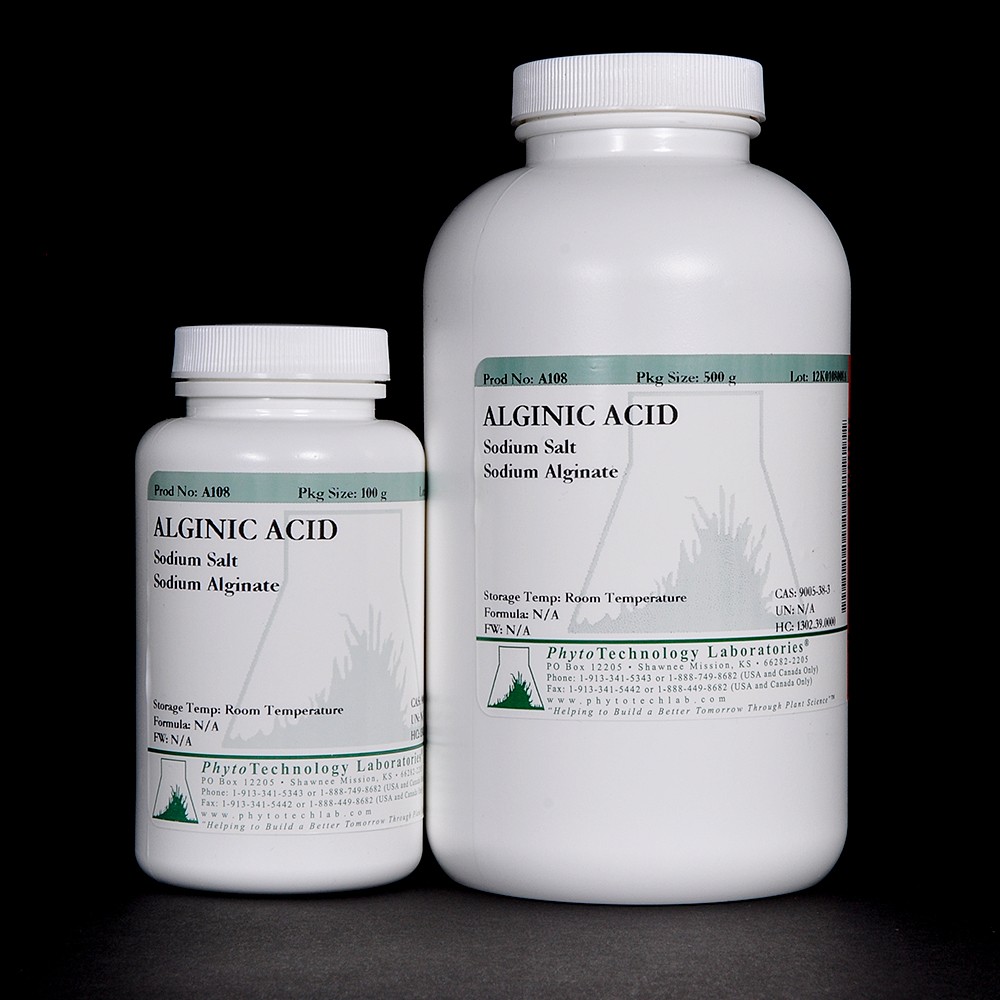Introduction
Description: Sodium Alginate requires calcium (~2 mM) to form a free-standing gel.
| Solubility |
Partially in Water |
| Suspension |
Viscuous Colloidal Suspension |
| Physical Form |
Solid |
| Storage Temp |
Room Temperature |
| Other Notes |
Plant Tissue Culture Tested |
| UPC / SKU |
A108 |
| CAS NUMBER |
9005-38-3 |
| Formula Weight |
240,000 Avg |
| Synonyms |
Sodium Salt, Sodium Alginate |
| Storage Temp. |
Room Temperature |
| Tariff Code |
3913.10.0000 |
| Risk Info (R) |
36/37/38 |
| Safety Info (S) |
36 |
No information available
A108 Alginic Acid, Sodium Salt
| Synonyms: |
Sodium Alginate |
| CAS: |
9005-38-3 |
| Properties |
|---|
| Form: |
Powder |
| Appearance: |
Off-white to Cream Powder |
| Application: |
Plant Tissue Culture Gelling Agent |
| Solubility: |
Soluble in Water – Slowly Forms Viscous Solution at 10 mg/mL w/ Stirring |
| Storage Temp: |
Room Temperature |
Application Notes
Alginic Acid has been used for a number of cell and tissue culture applications including use as a physical support similar to agarose and for the preparation of gelled beads. Both of these applications have been used to immobilize and embed suspension cells and protoplasts (Adaoha Mbanaso and Roscoe, 1982; Chee and Cantliffe, 1989; Draget et al., 1988; Larkin et al., 1988). Alginate solutions form a reversible gel at room temperature in the presence of calcium ions. The gel can be re-liquified with a chelating agent, such as citrate. Cells imbedded in gel matrices can be manipulated with significantly less physical damage during handling than cells in liquid medium. Alginate should be dissolved in a low calcium (e.g., 2 mM) buffered medium at 1.75 - 4.0% (w/v). If protoplasts are to be embedded in the gel then the medium should contain an appropriate osmoticum. Alginic acid will require several hours to dissolve. As it dissolves, the solution will increase in viscosity. This viscosity will negate filter sterilization through a 0.2 µm membrane; a 0.45 µm membrane can be used. While some researchers have indicated that alginate solutions can be autoclaved, Larkin et al. (1988) noted a reduction in bead-making capacity with increased autoclave time. If protoplasts are to be embedded, they should first be concentrated by centrifugation in a low calcium medium and added to alginate at an appropriate density (e.g., 1 x 105 cells/mL). The protoplast-alginate solution is added drop-wise to a solution containing 50 mM CaCl2 and an appropriate osmoticum. Each droplet will for a bead. The beads should remain in the CaCl2 for up to 45 minutes to ensure optimum gel matrix formation.
Please Note: It is the sole responsibility of the purchaser to determine the appropriateness of this product for the specific plants that are being cultured and applications that are being used.
References
Adaoha Mbanaso, E.N. and D.H. Roscoe, Plant Sci. Lett. 25, 61-66 (1982). Chee, R. and D.J. Cantliffe, In Vitro Cell. Develop. Biol., 25:757-760 (1989). Draget, K.I., S. Myhre, G. Skjåk-Bræk, and K. Østgaard, Plant Physiol., 132:552-556 (1988) Larkin P.J., P.A. Davies, and G.J. Tanner, Plant Sci., 58:203-210 (1988). Merck 13, 238.




